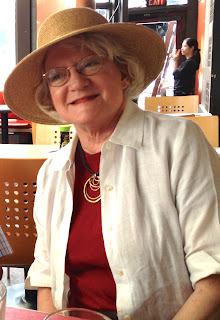When I read Michael Miller’s work, an image appears in my
mind of a poet sitting on a bench near Emily Dickinson’s house in Amherst,
Massachusetts where Miller walks daily and receives the Muse — perhaps even
Emily’s Muse. In fact, Miller’s latest book of poetry, In the Mirror, includes a poem entitled “Visiting Emily,” in
which he expresses the desire to ask the famous New England poet “…about
living, dying, /About the veins of a leaf/As thin as my white hair…” In this
poem, he imagines how Emily nods to a 200-year old oak, saying “in a barely
audible voice/That the finches will not/Be in mourning on the branches/ Once
all the leaves have fallen.” The poem is a salute to the bard of Amherst and to
an ancient oak whose branches point upward toward the Pelham hills.
I have enjoyed a sporadic correspondence with Michael Miller
during the last five years, and through readings of his e-mails and the poems
that reflect his rich inner life, I think that he represents the best of the
group of poets published by Pinyon Publishing, his books appearing almost yearly now through the nurturing of Pinyon and its editor Gary Entsminger.
Like Miller’s publisher I was especially moved by a long
poem entitled “A Woman Alone,” about the imagined life of a woman in her ninetieth
summer who is traveling on a bus to Barstow, California through the barren Mojave
Desert, “basking in the silence/Of miles, of cacti, of rocks embedded/In sand.
Only listen, she repeats…” I can easily visualize the scene Miller paints in
which the lonely woman misses her garden as I’ve spent many hours in the Mohave
and a week one summer near Barstow, comforted only by the sight of Joshua
trees. In the succinct verses of sometimes only six lines, this long poem
probes mortality with a combined high quality of insight and clarity, exploring
the remembrances and poignant laments of the aging:
“This time her daughter arrives
To help her move.
She dreads the open boxes,
What to put in, what to leave out,
Worries she is packing her life away
Never to be opened again.”
In V. of this long poem, Miller evokes his poetic powers
with force and brevity, recording the regrets of an old woman: “In the light of
the window, /With her still steady hands, /She is sewing a hole in her life, The
needle and thread/A companion from childhood/A contrast to the losses/Accumulated
through time …” This is a poem about resilience and hope, conveyed through the
surprising voice of an elderly person who has transcended loss and suffering.
At every turn, the reader joins in an exploration of
undisguised reality, revealing Miller’s sensitivity and awareness of the human
condition. However, we are treated to a bit of magic in poems like “Magician,”
in which the poet finds within himself a shared rapture with his grandson at
his first magic show where Miller “disappears inside him, /leaving [his] death
behind.”
In some of our e-mails, Miller has been kind enough to offer
evaluations of poems that I’ve published in The Pinyon Review, alongside his creations, but I’m quick to acknowledge his
fine, inspired work as profound artistic creations. The end poem, “The Clock’s
Hands,” is a lovely tribute to his wife whom he says he would regret leaving, “…leaving
the loveliness that has not grown old/But only deepened/With each wrinkle, each
gesture:/Spreading the marmalade, /Walking in the garden/To peruse your
blossoms,/Placing your pink blouse/On the chair’s straight back/And coming to
bed/With a smile beginning./I cannot imagine/Another paradise.”
This is a splendid collection of poems, honest and original,
and as I said in the opening paragraph of this blog, Miller represents the best
of Pinyon’s poets who have looked at the world and have clearly come to
recognize the magnitude of life.
Michael Miller’s poems have appeared in The Kenyon Review, The Sewanee Review, The New Republic, The Yale Review, and other publications. He won First
Prize for his poem, “The Different War,” awarded by the W.B. Yeats Society and
anthologized in Yeats 150. In the Mirror is his seventh book of poetry. Miller lives in Amherst,
Massachusetts, along with the same Muse who inspired Emily Dickinson, Robert
Frost, Robert Francis, and other outstanding New England poets. Salud, Michael!


















